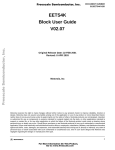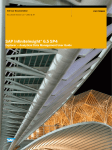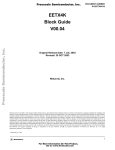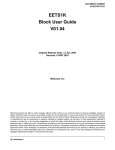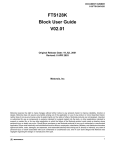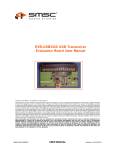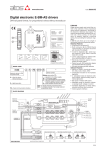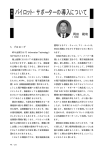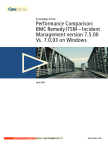Download EETS4K Block User Guide V02.03
Transcript
DOCUMENT NUMBER HCS12EETS4KUG/D EETS4K Block User Guide V02.03 Original Release Date: 22 FEB 2001 Revised: Oct 29, 2001 Motorola, Inc Motorola reserves the right to make changes without further notice to any products herein to improve reliability, function or design. Motorola does not assume any liability arising out of the application or use of any product or circuit described herein; neither does it convey any license under its patent rights nor the rights of others. Motorola products are not designed, intended, or authorized for use as components in systems intended for surgical implant into the body, or other applications intended to support or sustain life, or for any other application in which the failure of the Motorola product could create a situation where personal injury or death may occur. Should Buyer purchase or use Motorola products for any such unintended or unauthorized application, Buyer shall indemnify and hold Motorola and its officers, employees, subsidiaries, affiliates, and distributors harmless against all claims, costs, damages, and expenses, and reasonable attorney fees arising out of, directly or indirectly, any claim of personal injury or death associated with such unintended or unauthorized use, even if such claim alleges that Motorola was negligent regarding the design or manufacture of the part. 1 Block User Guide — HCS12EETS4KUG V02.03 Revision History Version Revision Effective Number Date Date Author Description of Changes 22 May 01 Block User Guide generated from generic HCS12 eets_hcs12_bg (V02.00) V02.01 25 May 01 Made formats SRS V2 compliant Removed non customer information like e.g. TSMC, SATO, .... Reordering and restructuring New overview block diagram V02.02 19 July 01 Document names have been added Names and Variable definitions have been hidden V02.03 29 Oct 01 Added descriptions for the WRALL bit and Address and Data registers. V02.00 2 Block User Guide — HCS12EETS4KUG V02.03 Table of Contents Section 1 Introduction 1.1 1.1.1 1.2 1.3 1.4 Overview. . . . . . . . . . . . . . . . . . . . . . . . . . . . . . . . . . . . . . . . . . . . . . . . . . . . . . . . . . . . . .9 Glossary . . . . . . . . . . . . . . . . . . . . . . . . . . . . . . . . . . . . . . . . . . . . . . . . . . . . . . . . . . . .9 Features . . . . . . . . . . . . . . . . . . . . . . . . . . . . . . . . . . . . . . . . . . . . . . . . . . . . . . . . . . . . . .9 Modes of Operation . . . . . . . . . . . . . . . . . . . . . . . . . . . . . . . . . . . . . . . . . . . . . . . . . . . .10 Block Diagram . . . . . . . . . . . . . . . . . . . . . . . . . . . . . . . . . . . . . . . . . . . . . . . . . . . . . . . .10 Section 2 External Signal Description 2.1 Overview. . . . . . . . . . . . . . . . . . . . . . . . . . . . . . . . . . . . . . . . . . . . . . . . . . . . . . . . . . . . .11 Section 3 Memory Map and Registers 3.1 Overview. . . . . . . . . . . . . . . . . . . . . . . . . . . . . . . . . . . . . . . . . . . . . . . . . . . . . . . . . . . . .13 3.2 Module Memory Map . . . . . . . . . . . . . . . . . . . . . . . . . . . . . . . . . . . . . . . . . . . . . . . . . . .13 3.3 Register Descriptions . . . . . . . . . . . . . . . . . . . . . . . . . . . . . . . . . . . . . . . . . . . . . . . . . . .15 3.3.1 ECLKDIV — EEPROM Clock Divider Register . . . . . . . . . . . . . . . . . . . . . . . . . . . . .15 3.3.2 RESERVED1 . . . . . . . . . . . . . . . . . . . . . . . . . . . . . . . . . . . . . . . . . . . . . . . . . . . . . . .16 3.3.3 RESERVED2 . . . . . . . . . . . . . . . . . . . . . . . . . . . . . . . . . . . . . . . . . . . . . . . . . . . . . . .16 3.3.4 ECNFG — EEPROM Configuration Register. . . . . . . . . . . . . . . . . . . . . . . . . . . . . . .17 3.3.5 EPROT — EEPROM Protection Register . . . . . . . . . . . . . . . . . . . . . . . . . . . . . . . . .17 3.3.6 ESTAT — EEPROM Status Register. . . . . . . . . . . . . . . . . . . . . . . . . . . . . . . . . . . . .19 3.3.7 ECMD — EEPROM Command Register . . . . . . . . . . . . . . . . . . . . . . . . . . . . . . . . . .20 3.3.8 RESERVED3 . . . . . . . . . . . . . . . . . . . . . . . . . . . . . . . . . . . . . . . . . . . . . . . . . . . . . . .21 3.3.9 RESERVED4 . . . . . . . . . . . . . . . . . . . . . . . . . . . . . . . . . . . . . . . . . . . . . . . . . . . . . . .21 3.3.10 RESERVED5 . . . . . . . . . . . . . . . . . . . . . . . . . . . . . . . . . . . . . . . . . . . . . . . . . . . . . . .22 3.3.11 RESERVED6 . . . . . . . . . . . . . . . . . . . . . . . . . . . . . . . . . . . . . . . . . . . . . . . . . . . . . . .22 3.3.12 RESERVED7 . . . . . . . . . . . . . . . . . . . . . . . . . . . . . . . . . . . . . . . . . . . . . . . . . . . . . . .22 Section 4 Functional Description 4.1 Program and Erase Operation . . . . . . . . . . . . . . . . . . . . . . . . . . . . . . . . . . . . . . . . . . . .25 4.1.1 Writing the ECLKDIV Register . . . . . . . . . . . . . . . . . . . . . . . . . . . . . . . . . . . . . . . . . .25 4.1.2 Program and Erase . . . . . . . . . . . . . . . . . . . . . . . . . . . . . . . . . . . . . . . . . . . . . . . . . .28 4.1.3 Valid EEPROM Commands . . . . . . . . . . . . . . . . . . . . . . . . . . . . . . . . . . . . . . . . . . . .29 4.1.4 Illegal EEPROM Operations. . . . . . . . . . . . . . . . . . . . . . . . . . . . . . . . . . . . . . . . . . . .30 3 Block User Guide — HCS12EETS4KUG V02.03 4.2 Wait Mode . . . . . . . . . . . . . . . . . . . . . . . . . . . . . . . . . . . . . . . . . . . . . . . . . . . . . . . . . . .31 4.2.1 Recovery From Wait Mode . . . . . . . . . . . . . . . . . . . . . . . . . . . . . . . . . . . . . . . . . . . .31 4.3 Stop Mode . . . . . . . . . . . . . . . . . . . . . . . . . . . . . . . . . . . . . . . . . . . . . . . . . . . . . . . . . . .31 4.4 Background Debug Mode. . . . . . . . . . . . . . . . . . . . . . . . . . . . . . . . . . . . . . . . . . . . . . . .32 Section 5 Resets 5.1 General. . . . . . . . . . . . . . . . . . . . . . . . . . . . . . . . . . . . . . . . . . . . . . . . . . . . . . . . . . . . . .33 Section 6 Interrupts 6.1 6.2 General. . . . . . . . . . . . . . . . . . . . . . . . . . . . . . . . . . . . . . . . . . . . . . . . . . . . . . . . . . . . . .35 Description of Interrupt Operation . . . . . . . . . . . . . . . . . . . . . . . . . . . . . . . . . . . . . . . . .35 4 Block User Guide — HCS12EETS4KUG V02.03 List of Figures Figure 1-1 Figure 3-1 Figure 3-2 Figure 3-3 Figure 3-4 Figure 3-5 Figure 3-6 Figure 3-7 Figure 3-8 Figure 3-9 Figure 3-10 Figure 3-11 Figure 3-12 Figure 3-13 Figure 4-1 Figure 4-2 EETS4K Block Diagram. . . . . . . . . . . . . . . . . . . . . . . . . . . . . . . . . . . . . . . . . . . .10 4K EEPROM Memory Map . . . . . . . . . . . . . . . . . . . . . . . . . . . . . . . . . . . . . . . . .14 EEPROM Clock Divider Register (ECLKDIV) . . . . . . . . . . . . . . . . . . . . . . . . . . .16 RESERVED 1 . . . . . . . . . . . . . . . . . . . . . . . . . . . . . . . . . . . . . . . . . . . . . . . . . . .16 RESERVED2 . . . . . . . . . . . . . . . . . . . . . . . . . . . . . . . . . . . . . . . . . . . . . . . . . . . .17 EEPROM Configuration Register (ECNFG) . . . . . . . . . . . . . . . . . . . . . . . . . . . .17 EEPROM Protection Register (EPROT) . . . . . . . . . . . . . . . . . . . . . . . . . . . . . . .18 EEPROM Status Register (ESTAT). . . . . . . . . . . . . . . . . . . . . . . . . . . . . . . . . . .19 EEPROM Command Buffer and Register (ECMD) . . . . . . . . . . . . . . . . . . . . . . .21 RESERVED3 . . . . . . . . . . . . . . . . . . . . . . . . . . . . . . . . . . . . . . . . . . . . . . . . . . . .21 RESERVED4 . . . . . . . . . . . . . . . . . . . . . . . . . . . . . . . . . . . . . . . . . . . . . . . . . . . .22 RESERVED5 . . . . . . . . . . . . . . . . . . . . . . . . . . . . . . . . . . . . . . . . . . . . . . . . . . . .22 RESERVED6 . . . . . . . . . . . . . . . . . . . . . . . . . . . . . . . . . . . . . . . . . . . . . . . . . . . .22 RESERVED7 . . . . . . . . . . . . . . . . . . . . . . . . . . . . . . . . . . . . . . . . . . . . . . . . . . . .22 PRDIV8 and EDIV bits Determination Procedure . . . . . . . . . . . . . . . . . . . . . . . .27 Example Program Algorithm . . . . . . . . . . . . . . . . . . . . . . . . . . . . . . . . . . . . . . . .29 5 Block User Guide — HCS12EETS4KUG V02.03 6 Block User Guide — HCS12EETS4KUG V02.03 List of Tables Table 3-1 Table 3-2 Table 3-3 Table 3-4 Table 4-1 Table 6-1 EEPROM Protection/Reserved Field. . . . . . . . . . . . . . . . . . . . . . . . . . . . . . . . . .13 EETS4K Memory Map . . . . . . . . . . . . . . . . . . . . . . . . . . . . . . . . . . . . . . . . . . . . .15 EEPROM Address Range Protection . . . . . . . . . . . . . . . . . . . . . . . . . . . . . . . . .19 ECMD EEPROM User Mode Commands . . . . . . . . . . . . . . . . . . . . . . . . . . . . . .21 NVM Valid User Mode Commands . . . . . . . . . . . . . . . . . . . . . . . . . . . . . . . . . . .30 EEPROM Interrupt Sources. . . . . . . . . . . . . . . . . . . . . . . . . . . . . . . . . . . . . . . . .35 7 Block User Guide — HCS12EETS4KUG V02.03 8 Block User Guide — HCS12EETS4KUG V02.03 Section 1 Introduction 1.1 Overview This document describes the EETS4K module which is a 4k byte EEPROM (Non-Volatile) Memory. The EETS4K block uses a small sector Flash memory to emulate EEPROM functionality. It is an array of electrically erasable and programmable, non-volatile memory. The EEPROM array is organized as 2048 rows of 2 bytes (1 word). The EEPROM block’s erase sector size is 2 rows or 2 words (4 bytes). The EEPROM memory may be read as either bytes, aligned words or misaligned words. Read access time is one bus cycle for byte and aligned word, and two bus cycles for misaligned words. Program and erase functions are controlled by a command interface. Both sector erase and mass erase of the entire EEPROM block are supported. An erased bit reads ‘1’ and a programmed bit reads ‘0’. The high voltage required to program and erase is generated internally by on-chip charge pumps. It is not possible to read the EEPROM array while it is being erased or programmed. The EEPROM is ideal for data storage for single-supply applications allowing for field reprogramming without requiring external programming voltage sources. WARNING A word must be erased before being programmed. Cumulative programming of bits within a word is not allowed. 1.1.1 Glossary Command Sequence A three-step MCU instruction sequence to program, erase or erase-verify the EEPROM. 1.2 Features • 4k bytes of EEPROM memory. • Minimum erase sector of 4 bytes • Automated program and erase algorithms. • Interrupts on EEPROM command completion and command buffer empty. • Fast sector erase and word program operation. • 2-stage command pipeline. • Flexible protection scheme for protection against accidental program or erase. • Single power supply program and erase. 9 Block User Guide — HCS12EETS4KUG V02.03 1.3 Modes of Operation • Program and erase operation (please refer to 4.1 for details) 1.4 Block Diagram Figure 1-1 shows a block diagram of the EETS4K module. EETS4K Command Interface Registers Command Pipeline comm2 addr2 data2 Oscillator Clock EEPROM Array 2048 * 16 Bits row0 row1 row2047 comm1 addr1 data1 Clock Divider EECLK Figure 1-1 EETS4K Block Diagram 10 Command Complete Interrupt Command Buffer Empty Interrupt Block User Guide — HCS12EETS4KUG V02.03 Section 2 External Signal Description 2.1 Overview The EETS4K memory contains no signals that connect off chip. 11 Block User Guide — HCS12EETS4KUG V02.03 12 Block User Guide — HCS12EETS4KUG V02.03 Section 3 Memory Map and Registers 3.1 Overview This section describes the EETS4K memory maps and registers. 3.2 Module Memory Map Figure 3-1 shows the EETS4K memory map. The EEPROM memory can be mapped to any 4K boundary in the MCU address range. Shown within the EEPROM block are a protection/reserved field and user defined EEPROM protected sectors. The EPOPEN bit in the EPROT register (see 3.3.5) can globally protect the entire memory block. However a protected area growing downward from the EEPROM space end address can be activated. The EEPROM module register space covers the addresses BASE + $110 to BASE + $11B. NOTE Register Address = Base Address + Address Offset, where the Base Address is defined at the MCU level and the Address Offset is defined at the module level. NOTE Chip security is defined at the MCU level. A 16 byte field is reserved inside the module from address $_FF0 to $_FFF. A description of these 16 bytes used in this field is given in Table 3-1. Table 3-1 EEPROM Protection/Reserved Field Address Size (bytes) Description $_FF0 - $FFC 13 Reserved $_FFD 1 EEPROM Protection byte $_FFE - $_FFF 2 Reserved 13 Block User Guide — HCS12EETS4KUG V02.03 EEPROM_START = $_000 (BASE + $110) EEPROM Control Registers (12 bytes) (BASE + $11B) 3.5K bytes $_E00 $_E40 $_E80 $_EC0 $_F00 EEPROM Protected High Sectors 64, 128, 192, 256, 320, 384, 448, 512 bytes $_F40 $_F80 $_FC0 EEPROM_END = $_FFF $_FF0 - $_FFF, EEPROM Protection/Reserved Field Figure 3-1 4K EEPROM Memory Map 14 Block User Guide — HCS12EETS4KUG V02.03 The EEPROM module has hardware interlocks which protect data from accidental corruption. A protected sector is located at the higher address end of the EEPROM block, just below $_FFF. The protected sector in the EEPROM can be sized from 64 bytes to 512 bytes The EEPROM module also contains a set of 12 control and status registers located in address space BASE + $110 to BASE + $11F. Table 3-2 gives an overview on all EETS4K registers. Table 3-2 EETS4K Memory Map Address Offset Use $_00 EEPROM Clock Divider Register (ECLKDIV) Access R/W $_01 1 RESERVED1 R $_02 RESERVED22 R $_03 EEPROM Configuration Register (ECNFG) R/W $_04 EEPROM Protection Register (EPROT) R/W $_05 EEPROM Status Register (ESTAT) R/W $_06 EEPROM Command Register (ECMD) R/W $_07 RESERVED33 R $_08 RESERVED44 R $_09 RESERVED55 R $_0A RESERVED66 R $_0B RESERVED77 R NOTES: 1. RESERVED1 intended for factory test purposes only. 2. RESERVED2 intended for factory test purposes only. 3. RESERVED3 intended for factory test purposes only. 4. RESERVED4 intended for factory test purposes only. 5. RESERVED5 intended for factory test purposes only. 6. RESERVED6 intended for factory test purposes only. 7. RESERVED7 intended for factory test purposes only. NOTE: Register Address = Base Address + Address Offset, where the Base Address is defined at the MCU level and the Address Offset is defined at the module level. 3.3 Register Descriptions 3.3.1 ECLKDIV — EEPROM Clock Divider Register The ECLKDIV register is used to control timed events in program and erase algorithms. 15 Block User Guide — HCS12EETS4KUG V02.03 Register address BASE + $110 7 R EDIVLD W RESET: 0 6 5 4 3 2 1 0 PRDIV8 EDIV5 EDIV4 EDIV3 EDIV2 EDIV1 EDIV0 0 0 0 0 0 0 0 = Unimplemented or Reserved Figure 3-2 EEPROM Clock Divider Register (ECLKDIV) All bits in the ECLKDIV register are readable, bits 6-0 are write once and bit 7 is not writable. EDIVLD — Clock Divider Loaded. 1 = Register has been written to since the last reset. 0 = Register has not been written. PRDIV8 — Enable Prescaler by 8. 1 = Enables a prescaler by 8, to divide the EEPROM module input oscillator clock before feeding into the CLKDIV divider. 0 = The input oscillator clock is directly fed into the ECLKDIV divider. EDIV[5:0] — Clock Divider Bits. The combination of PRDIV8 and EDIV[5:0] effectively divides the EEPROM module input oscillator clock down to a frequency of 150kHz - 200kHz. The maximum divide ratio is 512. Please refer to 4.1.1 for more information. 3.3.2 RESERVED1 This register is reserved and is not accessible to the user. Register address BASE + $111 7 6 5 4 3 2 1 0 R W 0 0 0 0 0 0 0 0 Reset: 0 0 0 0 0 0 0 0 Figure 3-3 RESERVED 1 3.3.3 RESERVED2 This register is reserved and is not accessible to the user. 16 Block User Guide — HCS12EETS4KUG V02.03 Register address BASE + $112 7 6 5 4 3 2 1 0 R W 0 0 0 0 0 0 0 0 Reset: 0 0 0 0 0 0 0 0 Figure 3-4 RESERVED2 3.3.4 ECNFG — EEPROM Configuration Register The ECNFG register enables the EEPROM interrupts. Register address BASE + $113 7 6 R W CBEIE CCIE Reset: 0 0 5 4 3 2 1 0 0 0 0 0 0 0 0 0 0 0 0 0 = Unimplemented or Reserved Figure 3-5 EEPROM Configuration Register (ECNFG) CBEIE and CCIE are readable and writable. Bits 5-0 read zero and are not writable. CBEIE — Command Buffer Empty Interrupt Enable. The CBEIE bit enables the interrupts in case of an empty command buffer in the EEPROM. 1 = An interrupt will be requested whenever the CBEIF flag, Figure 3-7, is set. 0 = Command Buffer Empty interrupts disabled. CCIE — Command Complete Interrupt Enable. The CCIE bit enables the interrupts in case of all commands being completed in the EEPROM. 1 = An interrupt will be requested whenever the CCIF, Figure 3-7, flag is set. 0 = Command Complete interrupts disabled. 3.3.5 EPROT — EEPROM Protection Register The EPROT register defines which EEPROM sectors are protected against program or erase. Register address BASE + $114 7 Read: EPOPEN Read: F Reset: 6 5 4 NV6 NV5 NV4 F F F 3 2 1 0 EPDIS EP2 EP1 EP0 F F F F = Unimplemented or Reserved 17 Block User Guide — HCS12EETS4KUG V02.03 Figure 3-6 EEPROM Protection Register (EPROT) The EPROT register is loaded from EEPROM array address $_FFD during reset, as indicated by the “F” in Figure 3-6. All bits in the EPROT register are readable. Bits NV[6:4] are not writable. The EPOPEN and EPDIS bits in the EPROT register can only be written to the protected state (i.e. 0). The EP[2:0] bits can be written anytime until bit EPDIS is cleared. If the EPOPEN bit is cleared, then the state of the EPDIS and EP[2:0] bits is irrelevant. To change the EEPROM protection that will be loaded on reset, the upper sector of EEPROM must first be unprotected, then the EEPROM Protect byte located at address $_FFD must be written to. A protected EEPROM sector is disabled by the EPDIS bit while the size of the protected sector is defined by the EP bits in the EPROT register. Trying to alter any of the protected areas will result in a protect violation error and bit PVIOL will be set in the EEPROM Status Register ESTAT. A mass erase of a whole EEPROM block is only possible when protection is fully disabled. EPOPEN — Opens the EEPROM for program or erase. 1 = The EEPROM sectors not protected are enabled for program or erase. 0 = The whole EEPROM array is protected. In this case the EPDIS and EP bits within the protection register are don’t care. EPDIS — EEPROM Protection address range Disable. The EPDIS bit determines whether there is a protected area in the space of the EEPROM address map. 1 = Protection disabled. 0 = Protection enabled. EP[2:0] — EEPROM Protection Address Size. The EP[2:0] bits determine the size of the protected sector. Refer to Table 3-3. 18 Block User Guide — HCS12EETS4KUG V02.03 Table 3-3 EEPROM Address Range Protection EP[2:0] Protected Address Range Protected Size 000 $_FC0-$_FFF 64 bytes 001 $_F80-$_FFF 128 bytes 010 $_F40-$_FFF 192 bytes 011 $_F00-$_FFF 256 bytes 100 $_EC0-$_FFF 320 bytes 101 $_E80-$_FFF 384 bytes 110 $_E40-$_FFF 448 bytes 111 $_E00-$_FFF 512 bytes NV[6:4] — Non Volatile Flag Bits. These three bits are available to the user as non-volatile flags. 3.3.6 ESTAT — EEPROM Status Register The ESTAT register defines the EEPROM state machine command status and EEPROM array access, protection and blank verify status. Register address BASE + $115 7 R W CBEIF Reset: 1 6 CCIF 1 5 4 PVIOL ACCERR 0 0 3 0 0 2 BLANK 0 1 0 0 0 0 0 = Unimplemented or Reserved Figure 3-7 EEPROM Status Register (ESTAT) Register bits CBEIF, PVIOL and ACCERR are readable and writable, bits CCIF and BLANK are readable and not writable, bits 3, 1 and 0 read zero and are not writable. CBEIF — Command Buffer Empty Interrupt Flag. The CBEIF flag indicates that the address, data and command buffers are empty so that a new command sequence can be started. The CBEIF flag is cleared by writing a “1” to CBEIF. Writing a “0” to the CBEIF flag has no effect on CBEIF but sets ACCERR if written during a command sequence. This bit, CBEIF, is used together with the enable bit CBEIE to generate the interrupt request. 1 = Buffers are ready to accept a new command. 0 = Buffers are full. 19 Block User Guide — HCS12EETS4KUG V02.03 CCIF — Command Complete Interrupt Flag. The CCIF flag indicates that there are no more commands pending. The CCIF flag is cleared when CBEIF is cleared and sets automatically upon completion of all active and pending commands. The CCIF flag does not set when an active command completes and a pending command is fetched from the command buffer. Writing to the CCIF flag has no effect. This bit, CCIF, is used together with the enable bit CCIE to generate the interrupt request. 1 = All commands are completed. 0 = Command in progress. PVIOL — Protection Violation. The PVIOL flag indicates an attempt was made to program or erase an address in a protected EEPROM memory area (see 4.1.4 Illegal EEPROM Operations) . The PVIOL flag is cleared by writing a “1” to PVIOL. Writing a “0” to the PVIOL flag has no effect on PVIOL. While PVIOL is set it is not possible to launch another command in the EEPROM. 1 = A protection violation has occurred. 0 = No failure. ACCERR — EEPROM Access Error. The ACCERR flag indicates an illegal access to the selected EEPROM array (see 4.1.4 Illegal EEPROM Operations) . This can be either a violation of the command sequence, issuing an illegal command (illegal combination of the CMDBx bits in the ECMD register) or the execution of a CPU STOP instruction while a command is executing (CCIF=0). The ACCERR flag is cleared by writing a “1” to ACCERR. Writing a “0” to the ACCERR flag has no effect on ACCERR. While ACCERR is set it is not possible to launch another command in the EEPROM. 1 = Access error has occurred. 0 = No failure. BLANK — Array has been verified as erased. The BLANK flag indicates that an Erase Verify command has checked the EEPROM array and found it to be blank. The BLANK flag is cleared by hardware when CBEIF is cleared as part of a new valid command sequence. Writing to the BLANK flag has no effect on BLANK. 1 = EEPROM array verifies as erased. 0 = If an Erase Verify command has been requested, and the CCIF flag is set, then a zero in BLANK indicates array is not erased. 3.3.7 ECMD — EEPROM Command Register The ECMD register defines the EEPROM commands. 20 Block User Guide — HCS12EETS4KUG V02.03 Register address BASE + $116 7 R W 0 Reset: 0 6 5 CMDB6 CMDB5 0 0 4 3 0 0 0 0 2 CMDB2 0 1 0 0 0 CMDB0 0 Figure 3-8 EEPROM Command Buffer and Register (ECMD) Bits 7, 4, 3 and 1 read zero and are not writable. Bits CMDB6, CMDB5, CMDB2 and CMDB0 are readable and writable during a command sequence. CMDB — Valid EEPROM User mode commands are shown in Table 3-4. Any other command than those mentioned in Table 3-4 sets the ACCERR bit in the ESTAT register (3.3.6). Table 3-4 ECMD EEPROM User Mode Commands Command Meaning $05 Erase Verify $20 Word Program $40 Sector Erase $41 Mass Erase $60 Sector Modify 3.3.8 RESERVED3 This register is reserved for factory testing and is not accessible to the user. Register address BASE + $117 7 6 5 4 3 2 1 0 R W 0 0 0 0 0 0 0 0 Reset: 0 0 0 0 0 0 0 0 Figure 3-9 RESERVED3 All bits read zero and are not writable. 3.3.9 RESERVED4 This register is reserved for factory testing and is not accessible to the user. 21 Block User Guide — HCS12EETS4KUG V02.03 Register address BASE + $118 7 6 5 4 3 2 1 0 R W 0 0 0 0 0 0 0 0 Reset: 0 0 0 0 0 0 0 0 Figure 3-10 RESERVED4 3.3.10 RESERVED5 This register is reserved for factory testing and is not accessible to the user. Register address BASE + $119 7 6 5 4 3 2 1 0 R W 0 0 0 0 0 0 0 0 Reset: 0 0 0 0 0 0 0 0 Figure 3-11 RESERVED5 All bits read zero and are not writable. 3.3.11 RESERVED6 This register is reserved for factory testing and is not accessible to the user. Register address BASE + $11A 7 6 5 4 3 2 1 0 R W 0 0 0 0 0 0 0 0 Reset: 0 0 0 0 0 0 0 0 Figure 3-12 RESERVED6 All bits read zero and are not writable. 3.3.12 RESERVED7 This register is reserved for factory testing and is not accessible to the user. Register address BASE + $11B 7 6 5 4 3 2 1 0 R W 0 0 0 0 0 0 0 0 Reset: 0 0 0 0 0 0 0 0 Figure 3-13 RESERVED7 22 Block User Guide — HCS12EETS4KUG V02.03 All bits read zero and are not writable. 23 Block User Guide — HCS12EETS4KUG V02.03 24 Block User Guide — HCS12EETS4KUG V02.03 Section 4 Functional Description 4.1 Program and Erase Operation Write and read operations are both used for the program and erase algorithms described in this section. These algorithms are controlled by a state machine whose timebase EECLK is derived from the oscillator clock via a programmable divider. The command register as well as the associated address and data registers operate as a buffer and a register (2-stage FIFO), so that a new command along with the necessary data and address can be stored to the buffer while the previous command is still in progress. The pipelined operation allows a simplification of command launching. Buffer empty as well as command completion are signalled by flags in the EEPROM status register. Interrupts for the EEPROM will be generated if enabled. The next four subsections describe: • How to write the ECLKDIV register. • The write sequences used to program and erase the EEPROM, but also to perform more sophisticated user commands like Sector-Modify and Erase-Verify. • Valid EEPROM commands. • Errors resulting from illegal EEPROM operations. 4.1.1 Writing the ECLKDIV Register Prior to issuing any program or erase command, it is first necessary to write the ECLKDIV register to divide the oscillator down to within 150kHz to 200kHz range. The program and erase timings are also a function of the bus clock, such that the ECLKDIV determination must take this information into account. If we define: • EECLK as the clock of the EEPROM timing control block • Tbus as the period of the bus clock • INT(x) as taking the integer part of x (e.g. INT(4.323)=4), then ECLKDIV register bits PRDIV8 and EDIV[5:0] are to be set as described in Figure 4-1. For example, if the oscillator clock is 950kHz and the bus clock is 10MHz, ECLKDIV bits EDIV[5:0] should be set to 4 (binary 000100) and bit PRDIV8 set to 0. The resulting EECLK is then 190kHz. As a result, the EEPROM algorithm timings are increased over optimum target by: ( 200 – 190 ) ⁄ 200 × 100 = 5% NOTE Command execution time will increase proportionally with the period of EECLK. 25 Block User Guide — HCS12EETS4KUG V02.03 WARNING Because of the impact of clock synchronization on the accuracy of the functional timings, programming or erasing the EEPROM cannot be performed if the bus clock runs at less than 1 MHz. Programming the EEPROM with an oscillator clock < 150kHz should be avoided. Setting ECLKDIV to a value such that EECLK < 150kHz can reduce the lifetime of the EEPROM due to overstress. Setting ECLKDIV to a value such that (1/EECLK+Tbus) < 5µs can result in incomplete programming or erasure of the memory array cells. If the ECLKDIV register is written, the bit EDIVLD is set automatically. If this bit is zero, the register has not been written since the last reset. Program and erase commands will not be executed if this register has not been written to. 26 Block User Guide — HCS12EETS4KUG V02.03 START Tbus < 1µs? no PROGRAM/ERASE IMPOSSIBLE yes =0 (reset) oscillator clock 12.8MHz? no yes =1 PRDCLK=oscillator clock/8 PRDCLK[MHz]*(5+Tbus[µs]) an integer? PRDCLK=oscillator clock no yes =INT(PRDCLK[MHz]*(5+Tbus[µs])) =PRDCLK[MHz]*(5+Tbus[µs]) - 1 TRY TO DECREASE Tbus EECLK=(PRDCLK)/(1+EDIV[5:0]) 1/EECLK[MHz] + Tbus[µs] > 5 yes AND EECLK > 0.15MHz ? END no yes EDIV[5:0] > 4? no PROGRAM/ERASE IMPOSSIBLE Figure 4-1 PRDIV8 and EDIV bits Determination Procedure 27 Block User Guide — HCS12EETS4KUG V02.03 4.1.2 Program and Erase A Command State Machine is used to supervise the write sequencing for program and erase. More specialized commands like sector-modify or erase-verify follow the same flow. Before starting a command sequence, it is necessary to check that there is no pending access error or protection violation (the ACCERR and PVIOL flags should be cleared in the ESTAT register). After this initial step the CBEIF flag should be tested to ensure that the address, data and command buffers are empty. If so, the command sequence can be started. The following 3-step command write sequence must be strictly adhered to and no intermediate access to the EEPROM array are permitted between the 3 steps. It is possible to read any EEPROM register during a command sequence. The command sequence is as follows: 1. Write the aligned data word to be programmed to the valid EEPROM address space. The address and data will be stored in internal buffers. For program, all address bits are valid. For erase, the value of the data bytes is don’t care. For mass erase, the address can be anywhere in the available address space of the block to be erased. For sector erase the address bits[1:0] are ignored for the EEPROM. 2. Write the program or erase command to the command buffer. These commands are listed in Table 4-1. 3. Clear the CBEIF flag by writing a “1” to it to launch the command. When the CBEIF flag is cleared, the CCIF flag is cleared by hardware indicating that the command was successfully launched. The CBEIF flag will be set again indicating the address, data and command buffers are ready for a new command sequence to begin. The completion of the command is indicated by the CCIF flag setting. The CCIF flag only sets when all active and pending commands have been completed. NOTE The Command State Machine will flag errors in program or erase write sequences by means of the ACCERR (access error) and PVIOL (protection violation) flags in the ESTAT register. An erroneous command write sequence will abort and set the appropriate flag. If set, the user must clear the ACCERR or PVIOL flags before commencing another command write sequence. By writing a 0 to the CBEIF flag the command sequence can be aborted after the word write to the EEPROM address space or after writing a command to the ECMD register and before the command is launched. Writing a “0” to the CBEIF flag in this way will set the ACCERR flag. A summary of the program algorithm is shown in Figure 4-2. For the erase algorithm, the user writes either a mass or sector erase command to the ECMD register. 28 Block User Guide — HCS12EETS4KUG V02.03 Read: Register ECLKDIV Clock Register Written Check Bit EDIVLD set? yes no Write: Register ECLKDIV 1. Write: Array Address and Program Data 2. Write: Register ECMD Program Command $20 NOTE: command sequence aborted by writing $00 to ESTAT register. 3. Write: Register ESTAT Clear bit CBEIF $80 NOTE: command sequence aborted by writing $00 to ESTAT register. Read: Register ESTAT Protection Violation Check Bit PVIOL Set? yes Write: Register ESTAT Clear bit PVIOL $20 no Bit ACCERR Set? Access Error Check yes Write: Register ESTAT Clear bit ACCERR $10 yes no Address, Data, Command Buffer Empty Check Bit CBEIF Set? yes Next Write? no no Bit Polling for Command Completion Check Bit CCIF Set? no Read: Register ESTAT yes EXIT Figure 4-2 Example Program Algorithm 4.1.3 Valid EEPROM Commands Table 4-1 summarizes the valid EEPROM User commands. Also shown are the effects of the commands on the EEPROM 29 Block User Guide — HCS12EETS4KUG V02.03 Table 4-1 NVM Valid User Mode Commands ECMD Meaning EEPROM $05 Erase Verify Verify all memory bytes of the EEPROM block are erased. If the array is erased the BLANK bit will set in the ESTAT register upon command completion. $20 Program Program a word (two bytes). $40 Sector Erase Erase two words (four bytes) of EEPROM. $41 Mass Erase Erase all the EEPROM array. A mass erase of the full block is only possible when EPDIS and EPOPEN are set. $60 Sector Modify Erase two words of EEPROM, re-program one word WARNING It is not permitted to program an EEPROM word without first erasing the sector in which that word resides. The Sector Modify command ($60) is a two-step command which first erases a sector (2 words) of EEPROM and then re-programs one of the words in that sector. The EEPROM sector which is erased by the Sector Modify command is the sector containing the address of the aligned data write which starts the valid command sequence. That same address is re-programmed with the data which is written. By launching a Sector Modify command and then pipelining a Program command it is possible to completely replace the contents of an EEPROM sector. 4.1.4 Illegal EEPROM Operations The ACCERR flag will be set during the command write sequence if any of the following illegal operations are performed causing the command write sequence to immediately abort: 1. Writing to the EEPROM address space before initializing ECLKDIV. 2. Writing a misaligned word or a byte to the valid EEPROM address space. 3. Writing to the EEPROM address space while CBEIF is not set. 4. Writing a second word to the EEPROM address space before executing a program or erase command on the previously written word. 5. Writing to any EEPROM register other than ECMD after writing a word to the EEPROM address space. 6. Writing a second command to the ECMD register before executing the previously written 30 Block User Guide — HCS12EETS4KUG V02.03 command. 7. Writing an invalid user command to the ECMD register in user mode. 8. Writing to any EEPROM register other than ESTAT (to clear CBEIF) after writing to the command register, ECMD. 9. The part enters STOP mode and a program or erase command is in progress. The command is aborted and any pending command is killed. 10. A “0” is written to the CBEIF bit in the ESTAT register. The ACCERR flag will not be set if any EEPROM register is read during the command sequence. If the EEPROM array is read during execution of an algorithm (i.e. CCIF bit in the ESTAT register is low) the read will return non valid data and the ACCERR flag will not be set. When an ACCERR flag is set in the ESTAT register the Command State Machine is locked. It is not possible to launch another command until the ACCERR flag is cleared. The PVIOL flag will be set during the command write sequence after the word write to the EEPROM address space and the command sequence will be aborted if any of the following illegal operations are performed. 1. Writing a EEPROM address to program in a protected area of the EEPROM. 2. Writing a EEPROM address to erase in a protected area of the EEPROM. 3. Writing the mass erase command to ECMD while any protection is enabled. When the PVIOL flag is set in the ESTAT register the Command State Machine is locked. It is not possible to launch another command until the PVIOL flag is cleared. 4.2 Wait Mode When the MCU enters WAIT mode and if any command is active (CCIF=0), that command and any pending command will be completed. 4.2.1 Recovery From Wait Mode The EETS4K module can recover the MCU from WAIT if the interrupts are enabled (see Section 6). 4.3 Stop Mode If a command is active (CCIF = 0) when the MCU enters the STOP mode, the command will be aborted, and the data being programmed or erased is lost. The high voltage circuitry to the flash will be switched off when entering STOP mode. CCIF and ACCERR flags will be set. Upon exit from STOP the CBEIF flag is set and any pending command will not be executed. The ACCERR flag must be cleared before returning to normal operation. 31 Block User Guide — HCS12EETS4KUG V02.03 WARNING As active commands are immediately aborted when the MCU enters STOP mode, it is strongly recommended that the user does not use the STOP command during program and erase execution. 4.4 Background Debug Mode In Background Debug Mode (BDM), the EPROT register is writable. If the chip is unsecured then all EEPROM commands listed in Table 4-1 can be executed. In special single chip mode if the chip is secured then the only possible command to execute is MASERS. 32 Block User Guide — HCS12EETS4KUG V02.03 Section 5 Resets 5.1 General If a reset occurs while any command is in progress that command will be immediately aborted. The state of the word being programmed or the sector / block being erased is not guaranteed. 33 Block User Guide — HCS12EETS4KUG V02.03 34 Block User Guide — HCS12EETS4KUG V02.03 Section 6 Interrupts 6.1 General The EETS4K block can generate an interrupt when all commands are completed or the address, data and command buffers are empty. Table 6-1 EEPROM Interrupt Sources Interrupt Source Interrupt Flag Local Enable Global (CCR) Mask EEPROM Address, Data and Command Buffers empty CBEIF (ESTAT register) CBEIE I Bit All Commands are completed on EEPROM CCIF (ESTAT register) CCIE I Bit NOTE Vector addresses and their relative interrupt priority are determined at the MCU level. 6.2 Description of Interrupt Operation For a detailed description of the register bits refer to the EEPROM Configuration register and EEPROM Status register sections (respectively 3.3.4 and 3.3.6). 35 Block User Guide — HCS12EETS4KUG V02.03 36 Block User Guide — HCS12EETS4KUG V02.03 Block Guide End Sheet 37 Block User Guide — HCS12EETS4KUG V02.03 FINAL PAGE OF 38 PAGES 38






































